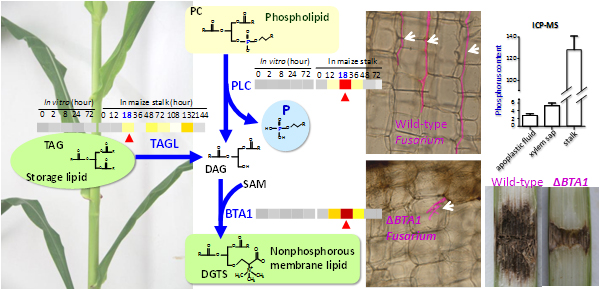In planta fungal gene profiling provides novel insights into Fusarium graminearum pathogenicity in maize stalk infection
The filamentous fungus Fusarium graminearum is the causative agent of Fusarium head blight inwheat and Gibberella stalk rot in maize. F. graminearum pathogenicity in wheat head blight has been extensively studied, whereas little is known about its pathogenicity in maize stalk infection.
Recently, a team led by Dr. Wei-Hua Tang at Institute of Plant Physiology and Ecology, SIBS, CAS, in collaboration with Dr. Yufeng Wang at University of Texas at San Antonio, tracked the F. graminearum invasion process inside maize stalk at the cellular level, and discovered that the fungus takes an intercellular growth route during the early stage. Laser microdissection and transcriptomic analysis revealed in planta stage-specific fungal infection dynamics. Subsequent system analysis and experimental validation elucidated that F. graminearum remodels membrane lipids to overcome the phosphate limitation in the intercellular space of maize stalks during the disease progression, revealing a novel adaptive strategy to increase the within-host fitness of this pathogen of critical agricultural and economic importance.
This study entitled “Cellular Tracking and Gene Profiling of Fusarium graminearum during Maize Stalk Rot Disease Development Elucidates its Strategies in Confronting Phosphorus Limitation in the Host Apoplast” was published in PLOS Pathogens on Mar 31, 2016. This work was supported by the grants from the Strategic Priority Research Program of the Chinese Academy of Sciences (XDB11020500) and National Basic Research Program of China (2011CB100702). SIPPE core facility provided strong technical support.
Contact:
Wei-Hua Tang, PhD, Professor
Institute of Plant Physiology & Ecology
Shanghai Institutes for Biological Sciences
Chinese Academy of Sciences
300 Fenglin Road
Shanghai 200032, China
 Figure. The nonphosphorus membrane lipid synthase BTA1 allows the fungal pathogen Fusarium graminearum to overcome phosphate limitation during intercellular invasion inside maize stalk.
Figure. The nonphosphorus membrane lipid synthase BTA1 allows the fungal pathogen Fusarium graminearum to overcome phosphate limitation during intercellular invasion inside maize stalk.
 Figure. The nonphosphorus membrane lipid synthase BTA1 allows the fungal pathogen Fusarium graminearum to overcome phosphate limitation during intercellular invasion inside maize stalk.
Figure. The nonphosphorus membrane lipid synthase BTA1 allows the fungal pathogen Fusarium graminearum to overcome phosphate limitation during intercellular invasion inside maize stalk.